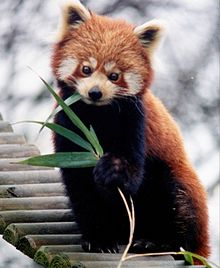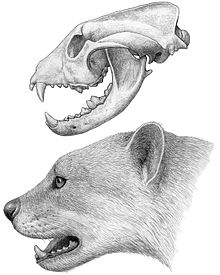Our website is made possible by displaying online advertisements to our visitors.
Please consider supporting us by disabling your ad blocker.
Ailuridae
| Ailuridae Temporal range:
| |
|---|---|

| |
| Red panda (Ailurus fulgens) | |

| |
| Skull and life restoration of Simocyon | |
| Scientific classification | |
| Domain: | Eukaryota |
| Kingdom: | Animalia |
| Phylum: | Chordata |
| Class: | Mammalia |
| Order: | Carnivora |
| Superfamily: | Musteloidea |
| Family: | Ailuridae Gray, 1843 |
| Subfamilies | |

| |
| Extant red panda distribution | |
Ailuridae is a family in the mammal order Carnivora. The family consists of the red panda (the sole living representative) and its extinct relatives.
Georges Cuvier first described Ailurus as belonging to the raccoon family in 1825; this classification has been controversial ever since.[1] It was classified in the raccoon family because of morphological similarities of the head, colored ringed tail, and other morphological and ecological characteristics. Somewhat later, it was assigned to the bear family.[2]
Molecular phylogenetic studies had shown that, as an ancient species in the order Carnivora, the red panda is relatively close to the American raccoon and may be either a monotypic family or a subfamily within the procyonid family.[1][3][4] An in-depth mitochondrial DNA population analysis study stated: "According to the fossil record, the Red Panda diverged from its common ancestor with bears about 40 million years ago."[1][5] With this divergence, by comparing the sequence difference between the red panda and the raccoon, the observed mutation rate for the red panda was calculated to be on the order of 109, which is apparently an underestimate compared with the average rate in mammals.[6] This underestimation is probably due to multiple recurrent mutations as the divergence between the red panda and the raccoon is extremely deep.[citation needed]
The most recent molecular-systematic DNA research places the red panda into its own independent family, Ailuridae. Ailuridae are, in turn, part of a trichotomy within the broad superfamily Musteloidea[7] that also includes the Procyonidae (raccoons) and a group that further subdivides into the Mephitidae (skunks) and Mustelidae (weasels); but it is not a bear (Ursidae).[8]
Ailurids appear to have originated during the Late Oligocene to Early Miocene in Europe. The earliest known member, Amphictis, was likely an unspecialised carnivore, based on its dentition. Ailurids subsequently dispersed into Asia and North America. The puma-sized Simocyon found in Middle Miocene-Early Pliocene of Europe, North America and China was likely a hypercarnivore. Like modern red panda it had a "false thumb" to aid in climbing. Members of the subfamily Ailurinae, which includes the modern red panda as well as the extinct genera Pristinailurus and Parailurus, developed a specialised dental morphology with blunted cusps, creating an effective grinding surface to process plant material.[9]
- ^ a b c Mayr, E. (1986). "Uncertainty in Science: is the Giant panda a bear or a raccoon?". Nature. 323 (6091): 769–771. Bibcode:1986Natur.323..769M. doi:10.1038/323769a0. PMID 3774006. S2CID 4317414.
- ^ Roberts, M.S.; Gittleman, J.L. (1984). "Ailurus fulgens". Mammalian Species (222). American Society of Mammalogists: 1–8. doi:10.2307/3503840. JSTOR 3503840.
- ^ Zhang, Y.P.; Ryder, O.A. (1993). "Mitochondrial DNA sequence evolution in the Arctoidea". PNAS. 90 (20): 9557–9561. Bibcode:1993PNAS...90.9557Z. doi:10.1073/pnas.90.20.9557. PMC 47608. PMID 8415740.
- ^ Slattery, J.P.; O'Brien, S.J. (1995). "Molecular Phylogeny of the Red Panda (Ailurus fulgens)". J. Hered. 86 (6): 413–422. doi:10.1093/oxfordjournals.jhered.a111615. PMID 8568209.
- ^ Bing, Su; Fu, Yunxin; Wang, Yingxiang; Jin, Li; Chakraborty, Ranajit (2001). "Genetic Diversity and Population History of the Red Panda (Ailurus fulgens) as Inferred from Mitochondrial DNA Sequence Variations". Molecular Biology and Evolution. 18 (6): 1070–1076. doi:10.1093/oxfordjournals.molbev.a003878. PMID 11371595.
- ^ Li, Wen-Hsiung (2007). Molecular Evolution. Sinauer Associates. ISBN 978-0-87893-480-5.[page needed]
- ^ Flynn et al., 2001[full citation needed]
- ^ Flynn, John J.; Nedbal, Michael A.; Dragoo, Jerry W.; Honeycutt, Rodney L. (1 November 2000). "Whence the Red Panda?" (PDF). Molecular Phylogenetics and Evolution. 17 (2): 190–99. Bibcode:2000MolPE..17..190F. doi:10.1006/mpev.2000.0819. ISSN 1055-7903. PMID 11083933. Archived from the original (PDF) on 13 April 2018. Retrieved 11 February 2018.
- ^ Salesa, Manuel J.; Peigné, Stéphane; Antón, Mauricio; Morales, Jorge (2022), "Evolution of the family Ailuridae: origins and Old-World fossil record", Red Panda, Elsevier, pp. 15–29, doi:10.1016/b978-0-12-823753-3.00007-7, ISBN 9780128237533, S2CID 243825496, retrieved 2022-06-29
Previous Page Next Page


